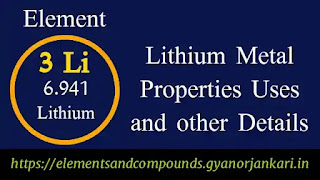Lithium Properties Uses and Other Details
What is Lithium
Lithium is classified as an alkali metal, and chemically it is an element.
Lithium is a very light metal of silver color, its density is
0.534 grams per cubic centimeter. Lithium is found in the solid state
at room temperature, with a melting point of 180.5 °C (356.9 °F) and
a boiling point of 1342 °C (2448 °F). The symbol for lithium is
Li. The atomic number of Lithium is 3 and its atomic weight is
6.941 AMU. An atom of Lithium has 3 electrons, 3 protons, 4 neutrons
and 2 energy levels. Lithium is located in Group 1, Period 2 and Block S in
the Periodic Table.
Lithium was discovered by Johann August Arfvedson in 1817.
 |
| Lithium Properties Uses and Other Details |
Properties of Lithium
- Lithium is a shiny silver colored metal.
- Lithium is a very soft metal, it is so soft that it can be cut with an ordinary knife and scratched with a fingernail.
- Lithium is much more reactive than water. When lithium is added to water, lithium hydroxide and hydrogen gas are formed. Lithium hydroxide is soluble in water.
- Lithium is a very good conductor of electricity and heat.
- Lithium has the highest specific heat of all the solid elements.
- There is a wide difference between the melting point and the boiling point of lithium.
- Lithium reacts with oxygen to form monoxide and peroxide.
- Lithium is a chemically active metal.
- Lithium does not react with oxygen at room temperature, but at 100 °C it reacts with oxygen to form lithium oxide (Li2O).
- Lithium combines with sulphur, hydrogen, nitrogen and halogens under special conditions.
- Lithium reacts with hydrogen at temperatures above 500 °C to form lithium hydride.
Uses of Lithium
- Lithium is most commonly used in making rechargeable batteries.
- Lithium is used to make non-rechargeable batteries, which are used in heart pacemakers.
- Liquid lithium is used as a coolant in nuclear reactors.
- Lithium is used to make lubricants.
- Lithium is used as an alloy to increase the capacity of copper, cadmium, magnesium and aluminum metals.
- Lithium has the highest specific heat of all solid elements, so it is used to make heat transfer devices.
- Lithium-magnesium alloy is used to make armor.
- Lithium-aluminum alloys are used in aircraft, high-end bicycle frames, and high-speed trains.
- Compounds of lithium are used in making porcelain.
- Lithium oxide is used in making special glasses and glass ceramics.
- Lithium carbonate is added to glass to make it stronger.
- Lithium chloride has the property of absorbing moisture, so it is used in industrial drying systems.
- Lithium Acetylureas are used in the synthesis of Vitamin A.
- Lithium carbonate is used in the treatment of patients with a mental illness called bipolar disorder.
- Lithium hydride is used to store hydrogen as a fuel.
- A small amount of lithium is added to the molten metal during the making of copper-nickel alloys, this lithium acts as a deoxidizer and reduces gas holes, bubbles and cracks in the metal.
- Lithium catalysts are used to make stronger synthetic rubbers.
Interesting Facts about Lithium
- Lithium is the lightest of all metals.
- Lithium is a lighter metal than water, so when lithium is added to water, it floats on top of the water.
- Lithium has been used to make the 200-inch-diameter glass of the Hale telescope on Mount Palomar.
- Most of the Lithium is produced in Australia.
- Lithium is kept in oil or in argon gas to store it, otherwise it can react with oxygen and moisture present in the air.
- Lithium is readily absorbed by plants, so trace amounts of lithium are found in plants.
- Lithium may explode upon contact with acids, oxidants, halogens, hydrocarbons, concrete, sand, asbestos, explosives and water.
- Lithium emits toxic gases when it catches fire, which can cause very serious health problems when exposed to them.
- In 2019, about 77000 tons of lithium were produced all over the world.
Detailed Information on Some other Metals
- Gold Properties Uses and other Details
- Silver Properties Uses and Other Details
- Mercury Properties Uses and other Details
- Platinum Properties Uses and other details
- Titanium Properties Uses and other Details
- Aluminium Properties Uses and other Details
- Copper Properties Uses and Other Details
- Iron Metal Properties Uses and Other Details
- Nickel Metal Properties Uses and other Details
- Plutonium | Properties | Uses | Other Details
- Uranium | Properties | Uses | Other Details






No comments:
Post a Comment